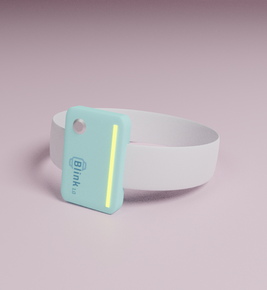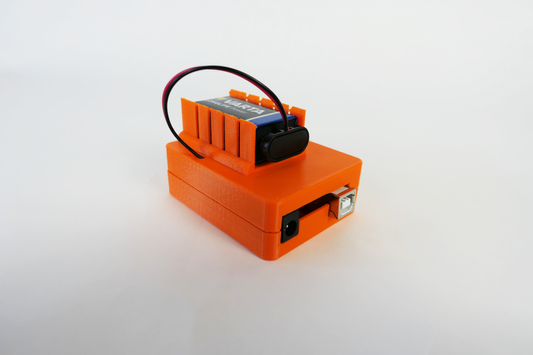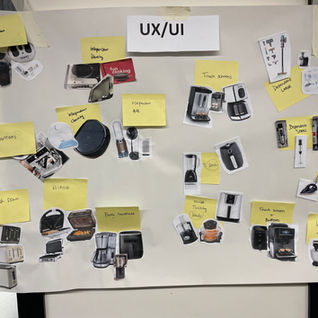Development based on expertise areas
Creativity & Aesthetics
Oe of the first courses that allowed me to develop my skills in Creativity & Aesthetics was Exploratory Sketching. During this course, I aimed to enhance my communication skills, translating ideas effectively to peers and professionals. Since I was initially drawn to purely aesthetics during sketching rather than communication, this course shifted my perspective. Due to my interest in drawing when I was younger, I had to develop a more exploratory mindset, realizing the importance of communicative sketches over perfection. In addition to this, During Aesthetics of Interaction, I worked on learning how to guide users through the functionalities of a design without additional information. Through prototyping, I learned the importance of focusing on key functions and avoiding unnecessary complexity. Challenges such as working with interaction relabelling and extreme characters highlighted the need for abstraction and innovation. Drawing inspiration from these exercises and experiences, our final design consisted of an alarm clock that integrated affordances, textures, and mechanics to ‘wake up’ from procrastination, emphasizing emotional expression and connection. This process revealed that the term Aesthetics of Interaction transcends conventional design norms and encourages different perspectives and innovation in interaction design. Furthermore, during my internship at the Fashion Tech Farm (FTF), I explored many techniques to create functional and aesthetic wearable products. My main project focused on a garment with integrated LEDs that could be manipulated by hand posture, using a gyroscope. The exploration of different light diffusing materials became an important step in the process of creating a seamless glow in the garment. Iterative improvements were made to increase usability and comfort. For instance, I drew inspiration from FTF’s vibe project, integrating a breathable material to cover the electronics, prioritizing aesthetics and wearability. Another design decision to enhance the aesthetics of the garment was the addition of a print. Using processing, I created a print that represented a flow field in the same color scheme as the LEDs. Combining both elements resulted in a visually cohesive garment. Lastly, during engineering design I experimented with Blender for the first time. I wanted to learn to communicate ideas digitally, opposed to just using sketches on paper. By modelling a digital version of our prototype, I was able to showcase what our concept would look like as a finished product.




User & Society
The course that introduced me to User & Society was User Centered Design (UCD), During this course we focused mainly on how to create a service that is optimal in terms of User Experience (UX). I learned many valuable skills during this process, such as making proper questionnaires, conducting interviews, creating personas and designing interfaces that are optimal for UX. I implemented and developed those skills in multiple courses and projects. One of those courses was Socio-Cultural Sensitivity. During this course, the main focal point was considering different cultures, idealogies and beliefs during a design process and looking at cultural problems from different perspectives. One of the assignments was making a documentary about a certain subculture, which makes you think about how to take the interview and what questions to ask. Another assignment was creating an outfit that represents a societal issue (e.g. deforestation). During other projects I developed my skills mainly by setting up and conducting user tests. These projects include P2, P3, Design Research and my FBP. During these projects, user testing was not only done to test our final product, but also to either answer a research question or to get feedback on certain aspects of the design concept. To summarize, I conducted user tests to test the preferred shaped of a product (P2) and to determine the preference between a VR experience and a conventional screen experience (P3). In addition to this, I conducted co-creation sessions to develop a meeting reflection tool (Design Research) and to explore different methods of visual feedback (FBP). During my FBP I also worked with a Data Enabled Design process. I used data in the form of qualitative feedback (coach/expert meetings, co-creation sessions, peer feedback) to continuously iterate on previous prototypes and features. By using research through design as a tool, I learned the value of user needs and opinions for the overall development of your product.



Math, Data and Computing
I developed the most in this EA during Project 2 Design and my FBP. During Project 2 Design I was in the Artifice squad, where we worked on creating a conversational agent that uses cognitive behavioral therapy to provide an accessible solution for students who struggle with stress and mental health. My role in this project was to develop the structure of the conversational agent. This introduced me to the program Dialogflow, which I used to create a network of conversational options for our product to resemble a real AI agent. Initially, the network was simplistic but after spending time troubleshooting and refining, I gained a profound understanding of how the program operated and created a more complex network of inputs and outputs. This process offered me many insights in the methods that machine learning driven products use to operate. Furthermore, during my FBP the main project was an interactive visualization tool, which meant that the prototype was mainly coded. One of the key aspects of the project was to capture accurate sparring data in boxing. This was a difficult challenge since there aren’t many accessible, low-cost data tracking options for the sport. I used processing libraries and many online tutorials to code an algorithm that enabled a depth camera that I used to accurately track the movement of boxers around the ring. To visualize the movements, I coded many iterations that used different graphs, heatmaps and interactive/communicative features to emphasize key data points. This process contributed greatly to my development in working with data, from capturing it to using it for valuable insights.



Technology and Realization
This is one of the EA’s I developed the most in during past projects. While working on my main project during my internship, I began with a small-scale circuit using an accelerometer/gyroscope and LEDs, gradually progressing to RGBW LED strips. To create the garment itself, I used machinery available at the FTF such as a laser cutter and overlock machines. For battery housing, I 3D printed a case that could hold both an Arduino and a battery pack for wireless use of the garment. Overall, the project allowed me to apply my knowledge on electronics and combine them with new skills, to show my development in the realization of wearable design. Another instance of me working with 3D printing was during the course Creative Mechanical Design, Engineering & Manufacturing. I used 3D modelling to print attachments for the housing of a flexible mirror that could be manipulated by servo motors (the design brief was to create a product that could evoke some sort of emotion). During this course I also worked on the material analysis of our design, gaining knowledge and experience in the use of different kind of materials to create designs with structural integrity. Lastly, during my USE learning line (sports & technology) I worked on creating a competitive sports environment for the Ketelhuisplein on a miniature scale. During this I developed my skills in combining coding with electronics, since the electronics had to be given certain instructions to provide a good representation of the project.




Business & Entrepreneurship
During Design Innovation Methods the main focus was to analyze a large company (In our case Netflix). I gained insights into business strategies, their priorities and even provided possible future improvements. Furthermore, during the course Trends & Forecasting, I got introduced to trend analysis and predictions. I aimed to enhance my skills in recognizing emerging trends and understanding the dynamics of successful brands. I explored different industries such as home appliances, the car industry , fashion, etc. and used tools such as designing for the far future to analyze what a design profession might look like many years from now. The course shifted my perspective on trends, emphasizing the importance of user preferences and the potential for growth in undiscovered market segments.



Collaboration & Professional skills
Over the past projects I have become more outspoken and involved in major design decisions. This helped me communicate my ideas and opinions better which has caused for better collaboration between me and my team members. In addition to this, I have gained experience in collaborating with stakeholders by joining meetings during my internship. This has taught me how to advance during a project in a professional setting.